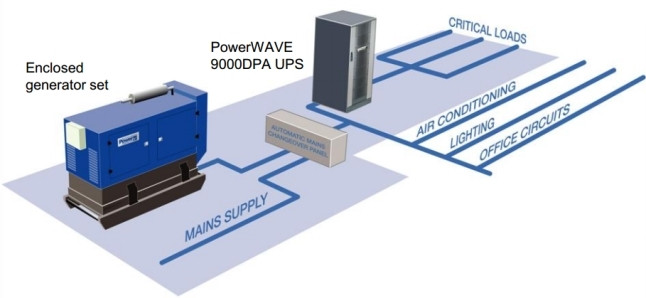Cape Town, 27 Feb 2015
Operating within the realities of South Africa's power supply, it is important to understand the impact on IT systems and be empowered to protect your data and hardware.
This article outlines combating power outages with (UPS) uninterruptible power supply and generators, and explains why a tandem system is the correct way to go.
An uninterruptible power supply (UPS) is an electrical apparatus that provides emergency power to a load when the input power source fails. A UPS differs from a generator in that it will provide near-instantaneous protection from power interruptions by supplying energy stored in batteries, super-capacitors or flywheels. Although the battery life of most uninterruptible power sources is relatively short, it is sufficient to start a standby power source or properly shut down your IT system.
A UPS is typically used to protect hardware such as computers, data centres, telecommunications equipment or other electrical equipment, where an unexpected power disruption could cause injuries, fatalities, serious business disruption or data loss. UPS units range in size from units designed to protect a single computer without a video monitor to large units powering entire data centres or buildings.
Although the primary role of any UPS is to provide short-term power when the input power source fails, it is also capable of correcting a range of other power problems, such as:
* Voltage spike or sustained overvoltage;
* Momentary or sustained reduction in input voltage;
* Noise, (defined as a high frequency transient or oscillation ), usually injected into the line by nearby equipment;
* Instability of the mains frequency; and
* Harmonic distortion (defined as a departure from the ideal sinusoidal waveform expected on the line).
UPS on its own will protect against short-term utility power loss and supply quality problems, but the UPS will eventually shut down when its batteries reach the end of their discharge period. Increasing the size or number of batteries will of course extend the autonomy time, but this is becoming more expensive as the rising cost of lead directly affects battery pricing. Irrespective of this, the exposure to blackout times exceeding the UPS battery autonomy will always remain a reality.
While a generator with a secure fuel supply can provide a source of power exceeding the duration of a blackout, it will not provide a no-break solution in the event of a loss of mains power.
It is therefore clear that the respective limitations of utilising a UPS or a standby generator alone are only fully overcome by operating these two different sources of backup power in tandem.
Summary
External battery packs are much more reliable than generators: mechanical generators are not fail-safe, and although a UPS with battery packs does require some extra testing maintenance, it is seemingly nothing when compared to that required for a generator - not to mention the mess you'll have to deal with if or when it fails you.

Share